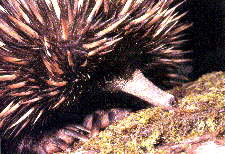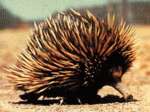Short-beaked Echidna

Photo: C & D Frith
Australia's Wet Tropics
Rainforest Life
Short-beaked Echidna: Tachyglossus aculeatus - It is a monotreme, crepuscular (active early morning and early evening).
- Other common names for the Echidna include the Spiny Anteater and Porcupine.
Characteristics: - The dorsal surface of the body and the tail is covered with spines.
- Fur is usually present between the spines.
- Have a long tubular snout.
- They both have a long and sticky tongue for feeding.
- The Short-beaked Echidna eats ants and other colonial insects.
- An echidna’s head and body length is between 30 and 45cm. Its weight is 2-7kg.
- Similar to a male platypus, the male echidna has a spur on the ankle of its hind-leg. However, it lacks the functional venom gland of the platypus.
Habitat: - This echidna has no particular habitat requirements, and is found in any Australian habitats.
- Shelter is found beneath thick bushes in hollow logs, under debris or in burrows.
Diet: - Forages around at dawn and dusk, and feeds on ants and termites.
- The echidna is a toothless animal, it invades an ant or termite nest with its forepaws or snout and extends its long tongue into the chambers. Insects stick to the stick saliva of the tongue and are drawn into the mouth. The insects are chewed between a horny pad at the back of the tongue and a similar pad on the palate.
Social Behaviour: Viewing Opportunities: - A difficult animal to predict as it rarely keeps the same route twice
- It avoids temperature extremes in arid regions by sheltering in caves or crevices and restricting activity to during the night. Activity patterns depend on air temperature in more temperate climates – it may be most active in the middle of the day in winter.
- Best viewed when crossing roadways early morning and early evening.
 Mating and Breeding: - Mating season is between July and August.
- Approximately 2 weeks after copulation, a single soft-shelled egg is laid, and hatches about 10 days later.
- The young remains in the pouch for a further 3 months, suckling on milk exuded from the pores of the paired mammary glands.
- The 3 month old echidna has a covering of short spines by the time it leaves the pouch.
- It then lives in an underground burrow for 7 or 8 months.
- they tend to first be seen when they're about one year old and weigh 1-2kg.
Predators and Defence: - Echidnas can curl into a ball of radiating spines if they are suddenly disturbed. Or, if on soil, they can dig beneath the surface while remaining horizontal to disappear like a sinking ship. It can also wedge itself securely in a rock crevice or hollow log by extending its spines and limbs.
- Dingoes occasionally eat echidnas, but due to their sharp spines, they have no significant predators.
- Young echidnas may be eaten by large goannas.
Additional Information: Environmental Protection Agency Echidnas and platypuses are the only egg-laying mammals (monotremes) in the world. Their peculiar egg-laying method of reproduction is thought to demonstrate the descent of mammals from reptiles. There are two species of echidnas, the larger long-beaked echidna found only in the highlands of New Guinea. and the short-beaked echidna, which lives in Australia and the New Guinean lowlands. Different forms of the long-beaked echidna were once found all over Australia and New Guinea until late Pleistocene times (about 11,000 years ago). Like the platypus, they are considered to have an ancient lineage and to have been around for over 100 million years. Its abundant sharp spines are consolidated hair. The echidna gets out and about to feed mainly at dawn and dusk. Top of the menu are termites and ants. It breaks into the nests of colonial insects, demolishing even the hard mud walls of a termite mound with its strong front feet. It pokes its long nose into cracks and extrudes an enormously long sticky tongue to which the helpless insects are glued like flies on flypaper. It possesses unique sensory capabilities. These include specialised nerve endings at the tip of its snout which are sensitive to tiny electric currents. These enable it to detect the minute electric signals produced by moving prey.
Script: Courtesy of Environmental Protection Agency Additional Information: Damon Ramsey The genus name Tachyglossus means 'swift tongue' (Strahan and Cayley 1995), and that swift tongue may slither in and out 100 times a minute (Strahan 1998). There are several different subspecies (Strahan and Cayley 1995) and the animal shows some variation in it's different environments; for example, those in Tasmania may grow hair that actually sticks out further than the spines. Although it is generally considered a widespread and common species, it is not regularly or predictably observed, most likely due to it's crepuscular and nocturnal activity especially, in the warmer parts of the continent. In the tropical rainforest it is only occasionally seen. Its wide distribution may be a reflection of the wide distribution of its prey. When feeding quite a bit of dirt is ingested (Strahan 1998), and this may assist in breaking down the insect prey. In the breeding season receptive females may waddle along followed by a trail of up to ten males (Cronin and Westmacott 2000).
Script: Courtesy of Damon Ramsey BSc.(Zool) Biologist Guide
|
